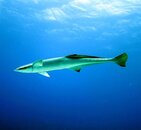Turneffe Flats
Registered
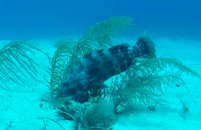

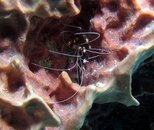
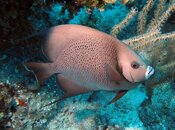
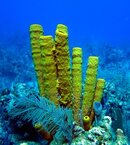
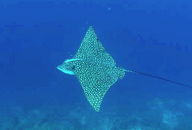
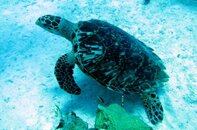
SOME OF THIS WEEK'S SIGHTINGS
11 – 13 May, 2014
Air Temperatures – Mid 80’s
Water Temperature – 82F
The week started out with winds coming from the east south east at 20 knots on Sunday morning. It shifted to the east on Monday continuing at 20 knots, then wind speeds slowed to 10 -15 knots on Tuesday. Partly cloudy conditions persisted for these three days. Winds speeds continued to drop and were below 10 knots out of the east on Wednesday, and switched to the north overnight to below 10 knots on Thursday with sunny conditions prevailing. Wind speeds picked up out of the north on Thursday night, and blew at 15 to 20 knots on Friday morning. Clouds moved in overnight as well giving us passing showers all day Friday and overcast skies for most of the day.
Our Boat Captain for three days of diving was Divemaster Denroy, and Dive Instructor Anne-Marie was the dive guide. Divers planned on only three days of diving as they had organized to spend a few days at the end of their week exploring the rainforest and caves in the Cayo District of Belize.
The strong easterly winds and an outgoing tide made our choice of diving the northwestern side of the atoll the best bet for the best visibility. We were not disappointed as we found 70 and 80 feet of visibility at Elkin’s Bay and Chasbow’s Corner, which was perfect for our divers as they were outfitted with both still and video cameras. During the three dives we completed at these sites, diving north and south of the mooring at Elkin’s Bay for the first two dives, we had very good sightings of Eagle Rays, Hawksbill Turtles, free swimming Green Moray Eels, and great photo subjects such as Gray Angels and Coral Banded Shrimp. On the third dive at Chasbow’s Corner, we had just come down the side of the wall at the beginning of the dive when a huge Spotted Eagle Ray adorned with Remoras swam up the wall at close range, and several feet below it a 4-foot Cobia followed along cautiously hanging several feet below along the wall. Also of interest, and quite annoying, were two large Remoras that started following the divers from the beginning of the first dive. They multiplied to three for dive two, then numbered five by the end of dive three, and had obviously followed the boat from Elkin’s Bay to Chasbow’s Corner. During the course of the three dives, they came up to divers nipping at cameras and lanyards, tugging on pony tails, and tasting divers’ legs and hands. Although their teeth are more like sandpaper, they were still able to give an abrasive bite which leaves a bit of a red welt. This was altogether, a most unusual occurrence.
We returned to the northwest for the second day on Monday as the same conditions prevailed. We visited the Terrace, Mandy’s Dandy, and then Tunnels & Barrels for the three dive sites of the day, all of which yielded 70 feet of visibility. Pointed sightings for the day were a large Spotted Eagle Ray, plentiful Nassau and Black Groupers, a Hawksbill Turtle, Cubera Snapper, Mackerel appearing like benign predators, a Tiger Grouper with a mouth full of Neon Gobies hanging over a Yellow Tube Sponge, and a Gray Encrusting Sponge that looked as if it was gray goo poured on to the coral it was colonizing. Also of interest were a number of Red-Spotted Siphonophores that were found in the water column at about 10 to 30 feet below the surface. These Cnidarians can produce an intense sting that, thank goodness, does not last long.
Divers were looking forward to going to Lighthouse Reef and the Blue Hole, but the easterly winds would not cooperate rendering surface conditions that would not allow for the trip on Tuesday. As a consolation, and not a bad one at that, we took them to the Elbow for their third day of diving, and then went to sites to the west of Turneffe for the second and third dives of the day at Tarpon Bay and then South Creekozene. Visibility at the Elbow was at 60 feet, the current was gentle running south at barely a half knot, as the tide was just starting to go out. Schools of Rainbow Runners darted by, and a number of Cubera, Dog and Mutton Snapper were scattered loosely around the towering coral spurs. A Green Moray Eel followed a chunky Black Grouper off the side of the wall, while two large King Fish swam high in the water column on the hunt just below the surface. A Hawksbill Turtle swam slowly up and over one of the coral spurs giving the photographers plenty of opportunity for good shots. A total of eight Spotted Eagle Rays were seen throughout the dive swimming alone, in pairs, and then in a threesome. Permit were observed schooling near the surface as Creole Wrasse seemed to fill the water column. A school large of Dog Snapper accompanied by a dozen or so Atlantic Spade Fish showed up as divers headed for a safety stop. At Tarpon Bay for dive two, visibility was at 80 feet and divers watched a school of 23 Mackerel pass them by, and Mackerel Scad zoomed by in tight protective schools. There were more Mackerel Scad at South Creekozene with Black Groupers in the water column glaring covetously at the darting, shimmering Scad. Photographers had 80 feet of visibility again here, and no shortage of opportunities with two Hawksbill Turtles showing up, one of which remained in the sand for several seconds before moving off slowly, and a large Black Grouper nestled in soft coral with Pederson Shrimp busy cleaning its mouth and gills. A juvenile Pygmy Filefish was found hiding next to a sponge encrusted soft coral branch, and many more Red-Spotted Siphonophores were seen in the water column. Diver had to be careful to avoid them while shallowing-up near the end of the dive, and during the safety stop.
Divers had a great three days of diving, coming away with some good photos and videos, many more dive sites to visit, and good reasons to plan a return trip.



